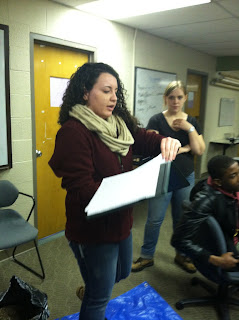Abby, Tierney, and I did our first teaching at MNIC yesterday, and I thought it went really well. I think Abby took some pictures so maybe she can add them :)
We started by going around the room saying our names, where we're from, and something we did over spring break. If we repeat this activity again (which I think we should because the students really enjoy discussion time), we need to make it faster and a more engaging/less distracting topic. Tierney had the idea in the car on the way back that we should have everyone say name and one idea for marketing microgreens.
Next, we asked everyone what they know about microgreens. We wrote the discussion points on the board. After that I taught basic seed anatomy (seed coat, plumule, hypocotyl, radical, cotyledon) with a drawing on the board. We discussed what each was and its function in the seed. After this we planted microgreens in small Driscols quart containers.
Next, Tierney led a discussion about the differences between microgreens and sprouts. After the discussion, we did an activity that I thought was really successful. Tierney passed out pictures of sprouts and of microgreens and students had to say whether or not their picture was a sprout or a microgreen and why. The students were paying attention and participating the whole time and it tied in really nicely to the seed anatomy lesson.
Finally we ended the hour with a review game for seed anatomy. I thought this activity was also really successful because the students were paying attention and participating. I passed out 10 cards--5 had definitions of each part of the seed, and 5 had pictures and names of these parts. Students had to find their matching card and then we reviewed all the answers as a class.

We gave MNIC the rest of our soil and seeds, and as we were leaving students from the class were showing some late comers how to sow the microgreens :) Overall, I thought we did pretty well. We are meeting with YEA corp again on Friday to plan what we will be doing next time!
How is everyone else doing with teaching?
Have a great weekend!

Jenny




























